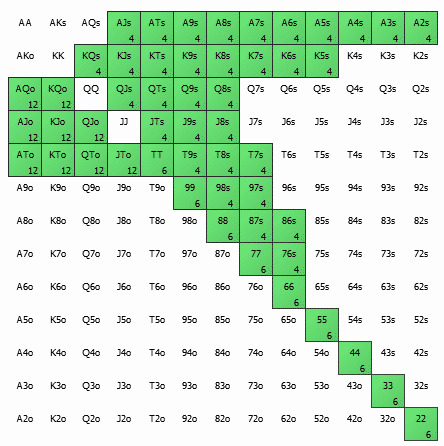Poker Button Calling Range
- Poker Button Calling Range Extender
- Poker Button Calling Range Hood
- Poker Button Calling Range Hoods
- Poker Button Calling Ranges
DECISION POINT: In a tournament it folds to you in the hijack seat and you raise with . The cutoff folds, then the button reraises all in. Both blinds fold. Action is on you...
PRO ANSWER: Any time your opponent is all in, you should determine your pot odds. In this case, there are around 8,000 chips in the pot and it costs you an additional 4,950 to call, giving you pot odds of 8,000-to-4,950 or about 1.6-to-1.
Poker Button Calling Range Extender
UTG opens a 17% range and I construct a cold calling range from MP/CO/BTN, but the number of hands i think I should flat doesn't change that much. I will fold some smaller PP in MP/CO which I would flat on the button, but the number of suited broadway hands doesn't change that much. If we get a call, that range changes dramatically. We can assume that they only call with A-Qo – A-To; A-Qs – A-2s, 9-9, 8-8, 2-2, T-8s, 9-8s, and 8-7s while they fold everything else for good reasons. Against this range, our hand has only 39% equity. That call has an effect on how we proceed, of course.
PRO ANSWER: Any time your opponent is all in, you should determine your pot odds. In this case, there are around 8,000 chips in the pot and it costs you an additional 4,950 to call, giving you pot. Villain must call $73 to win $127.50, which is 1.74-to-1 pot odds. So, if Hero’s river betting range should contain 1 bluff for every 1.74 value hand. If we divide Hero’s value combos (13) by Villain’s pot odds (1.74), we get 13/1.74 = 7.47. At some places you can get Poker Button Calling Range casino deposit bonuses on more than just your first deposit, some casinos will give you deposit bonuses all the way till you fifth deposit. In the section below you can read more about how to evaluate different casino offers you might Poker Button Calling Range come across.
Given these odds, you need to have at least 38 percent equity in the hand to continue (1.6-to-1 is roughly equal to 62-to-38). Another way to calculate the equity needed to call is to divide the call amount by the total future pot size (4,950 / 12,950 = 0.38 or 38 percent).
Holding , we are likely to have more than 38 percent equity against most opponents' hand ranges. We have just over 38 percent equity against the hand range of 77+, AJs+, KQs, AJo+, KQo — that is, pocket pairs or higher, or higher (suited and offsuit), and (suited and offsuit).
Thus we can use this hand range as a milestone for our estimated profitability. If our opponent has this hand range or wider, we should call. If our opponent has a narrower hand range than this, we should fold.
Many opponents will reshove their 15-big blind stack with a much wider hand range than this, therefore we should call this all-in as our default play. We would need information that a specific opponent reshoves only with fewer, more premium hands in order for us to fold this hand preflop.
However, in general, calling this preflop all-in is the best play.

LearnWPT is a poker training site dedicated to transforming the poker games of rank beginners, skilled amateurs, and aspiring professionals. Offering both Live Workshops and Online Training, is a one-stop shop for poker education, designed to provide all the tools a player needs to become a winner. Visit LearnWPT.com today and get 2 Free Strategy Episodes that will immediately impact how you play. LearnWPT.com - Think Like a Pro!
Poker Button Calling Range Hood

Poker Button Calling Range Hoods

Poker Button Calling Ranges
Tags
tournament strategyno-limit hold’empocket pairspreflop strategypot oddsstack sizesrange readinghand readingequityLearnWPT